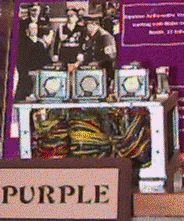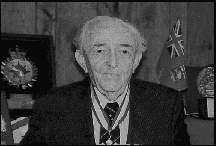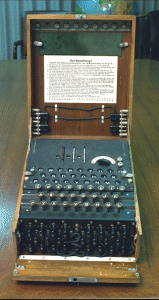 Golden Nuggets from U. S. History
The Blue Quill Series THE ULTRA SECRETBefore and during WW II the allies accumulated thousands, perhaps millions, of secrets. Some secrets seemed trivial at the time but proved to be highly significant after the war. One such well kept activity was the recruitment of American Indians, especially Navajo, for use as radiomen to speak in their native language. These wonderful soldiers were used in both Europe and the Pacific to communicate with distant units, totally befuddling the Germans and Japanese who worked mightily to break the mysterious 'code.' On the other end of the spectrum were such secrets as the Manhattan Project which, as the world now knows, led to the atomic bomb and ended the war with Japan. HERBERT O. YARDLEY In a group of big time secrets is one with two prongs. It involved the Japanese diplomatic code called PURPLE and the Japanese military encryption code which was a mutation of PURPLE. In the 1930's an American, Herbert O. Yardley, broke the secret code. Yardley had spent several years roaming the Orient, mostly in China and Japan, and became known to the public as an author. Strangely, he is best know for his book Education of a Poker Player, published after WW II, in which he boasts that over a period of forty years he never lost at poker for more than two consecutive 'sittings.' This code-breaking, numbers-crunching genius then proceeds to explain a system of poker which, if followed, guarantees one will not lose at poker except during runs of extremely bad luck. Bad luck does not mean your cards. Bad luck is when the other player is hitting inside straights and straight flushes. He claims that all his years in Asia were financed with poker winnings -- supplemented by occasional commissions from Uncle Sam for clandestine work. Yardley had a hobby, or avocation... spying. He was not a real American spy as shown in the movies. America didn't have regular spies in those days. There was no CIA, or NSA, or any other such organization. But Yardley spied anyway because he liked it. He simply observed events and men of governments and when he learned something interesting he contacted the American government and sold it to them. He was a loyal American and, therefore, had only one customer... well mostly one customer. As the situation in Japan grew ominous in the late 1930's Yardley, who by then was spending most of his time in China, became a supplier of information to a young Chinese military leader named Chiang Kai-shek. In 1949 Chiang Kai-shek and his army fled communist China and founded today's Taiwan. Yardley had two abiding principles... never sit in a poker game with a sucker and never give a sucker an even break. A sucker was anyone who could not be bluffed in poker games or negotiations and therefore, their thinking was not rational. He considered the Japanese leaders as suckers. His reasoning was simple... suckers hit inside straights... ergo suckers cannot be trusted.
After Yardley's triumph over PURPLE, other American code-breakers unraveled the Japanese military code. The U. S. then recruited ATT and IBM to build a computer, dubbed MAGIC, which whirred away throughout WW II deciphering Japanese code and winning such battles as Coral Sea and Midway. Yardley had not always been a roving gambler. His genius for numbers and cryptology (code making/breaking) appeared long before WW I. In 1917 and 1918 the US Army created, within the Military Intelligence Division, The Cipher Bureau (MI-8,) under Yardley's direction. It would have been unthinkable for Yardley to be associated with an organization with such a mundane name as MI-8, MID, or even The Cipher Bureau -- so it was soon dubbed the "Black Chamber." Yardley enjoyed the challenge and stayed on the job until 1929 when the bureaucrats started tinkering and moved much of the crypto-logical functions into a new unit, the Signal Intelligence Service, under cryptanalyst WILLIAM FREDERICK FRIEDMAN, and in so doing lost much of the secrecy surrounding Yardley's work.
Yardley decided that if the federal government didn't think his work important perhaps the public would have a different view. So without bothering to get permission he wrote his first book titled The American Black Chamber in which he described his work at The Cipher Bureau. One thing he revealed was that The Black Chamber had been decoding Japanese diplomatic cipher for several years. Needless to say, the Army, which continued code-breaking, was not amused. And the Japanese, as one would expect, changed their code systems. Yardley knew that FRIEDMAN had nothing to do with the closing of his unit and besides, Friedman was a numbers genius himself. He and Yardley had often collaborated on tough problems. It was only natural therefore, that when Yardley assumed his nomadic life in Asia, Friedman was the one he called to pass along tidbits of information. But the ULTRA SECRET developed in Europe and involved an elite group of very special people, a not so elite group of low-life bottom-feeders, bizarre events, strange twist, and an ending not yet determined. Another book was published in 1978 (paperback) and was written by a Canadian, SIR WILLIAM STEPHENSON. It's title was, Man Called Intrepid, and William Stephenson was Intrepid. A third book on the subject of ULTRA, unfortunately, is the most famous. The Ultra Secret was published in the name of a low-life bottom-feeding former office clerk who prostituted himself by allowing British intelligence units, MI5 and MI6, to use him to discredit Stephenson. The clerk was F.W. Winterbotham and Winterbotham HAD to be in on the MI5/6 propaganda about Stephenson because he WAS a clerk in the code-breaking operations of ULTRA. MI5/6 did a brilliant job in their efforts to destroy Stephenson... they made sure the book "by" Winterbotham was MOSTLY true, and it is. The only exceptions are: They promote Winterbotham from a clerk to a real hot-shot code-breaker -- they take advantage of laws in 1978 which would not allow exposing the REAL code-breakers -- and they very deftly transfer key achievements from Stephenson to mysterious British code-breakers. The last subterfuge was to take advantage of the common practice of American historians and press corps to protect someone they like. Historians and the press love Franklin D. Roosevelt and are determined to protect his legacy for honesty and straight-shooting. They refuse to give FDR credit for breaking dozens, maybe hundreds, of federal laws during the 1930's. But in doing so they deprive him of the credit for perhaps saving tens of thousands of lives in the process. In protecting FDR they are forced to rob credit from another real American hero; "Wild" Bill Donovan who was a key player in the Ultra Secret saga. When Stephenson wrote Intrepid some of the information was still classified so he was forced to write around certain facts, i. e., fictionalize portions of his story. Within a year, more material was "released" which did not support some unimportant details of Stevenson's book. The release of the new material came without official clearance -- leaked from London. The campaign was on to destroy a most remarkable man... and for the silliest of reasons. British code-breakers despised the fact that a CANADIAN was the real achiever in an effort to solve German secret codes. A few definitions:
ENIGMA was a German encryption machine originally named Chiffriermaschinen Aktiengesellschaft but fortunately dubbed ENIGMA by the allies. WILLIAM "WILD BILL" DONOVAN
William Donovan was born on New Year's Day 1883, in Buffalo, New York. He wanted to be a lawyer and pursued his goal, graduating from Columbia University in 1905 and Columbia Law School in 1907. In 1912 he formed his own cavalry troop and fought in Mexican border skirmishes. In World War I he was with the US Army's 165th Infantry in France, wounded three times, and awarded several medals, including the Congressional Medal of Honor. His regiment was the famous Fighting 69th which was used as the basis of a James Cagney-Pat O'Brien movie of the same name. Donovan moved up in rank to command the unit and emerged from the war as a Colonel. It was between WW I and WW II that he became involved in military intelligence and on a trip to England he met William Stephenson.
William Stephenson was born January 11, 1896 near Winnipeg, Canada. In 1914 he enlisted in the Royal Canadian Engineers, and was commissioned before his 19th birthday. Fighting as a foot soldier in France, he was gassed and had to recuperate in England. He then earned his wings in the Royal Flying Corps and became an ace combat pilot. For his service he received the Military Cross, Distinguished Flying Cross, the Croix de Guerre avec Palmes, and the Legion d'Honneur. Leaving service at the end of the war Stephenson returned to Canada and embarked on a remarkable, albeit short, career of invention and achievement. He invented communications equipment for a budding telephone industry and became a multi-millionaire. Concerned about economic struggles overseas he returned to Europe.
Intrepid had made engineering drawings from the stolen Chiffriermaschinen Aktiengesellschaft. With these drawings he talked to key factory workers and determined what major differences there were between the stolen machine and the production units of ENIGMA. From these results he determined which parts must be smuggled out. He wanted only the NEW parts because he had already cloned the old machine. When he had accumulated enough parts he had the underground implement phase two. They targeted a truck transporting an ENIGMA, killed the occupants, removed the ENIGMA, and put in the smuggled parts. They then put in enough explosives to blow the truck and contents into small pieces. When the Germans investigated they found a simple matter of Polish sabotage and of course a completely destroyed ENIGMA. The Germans probably had a great laugh because clearly, these amateurs had used far too many explosives. Stephenson carefully disassembled the hijacked ENIGMA, prepared detailed engineering drawings and had several more machines made. These were the machines which ended up at BLETCHLEY PARK, delivered to them by a Canadian. At least one of the clones was delivered to the United States but Roosevelt agreed with Churchill to let BLETCHLEY PARK carry the ball so the code-breaking took place there although, reluctantly, the Brits had accepted FRIEDMAN and his staff. Thousands of German messages were decoded manually and the information relayed to field commanders but thousands more went un-decoded because of the delay in building a working computer at BLETCHLEY PARK. MAGIC would have reduced this delay by TWO YEARS! RECOGNITION In 1945 Intrepid appeared before King George and was knighted, thus becoming SIR WILLIAM STEPHENSON. The following year President Harry Truman awarded Intrepid the Presidential Medal for Merit, the first non-American to receive the highest US honor for a civilian. Stephenson was the only one associated with ULTRA who was so honored! After the war, Sir William and Lady Mary moved to the Caribbean, settling first in Jamaica. Working with the Governor, Stephenson started a regional cement industry and spearheaded world-wide investments to boost the economies of underdeveloped countries. He then retired to Bermuda with Lady Mary. Writer Tim Lawson wrote a biography on Stephenson titled The Quiet Canadian and visited with him and Lady Mary on Bermuda in 1985. Said Lawson, Intrepid died on Bermuda in 1989 at the age of 93. Philosophos Historia
| ||||||||||
© 1999-2001 Concord Learning Systems, Concord, NC. All rights reserved. 
| ||||||||||




 Stephenson and Donovan maintained close contacts as the war in Europe neared. One matter they exchanged views on was a German encryption machine, Chiffriermaschinen Aktiengesellschaft. This device had been invented in Poland and sold to the Germans who incorporated it into their military and diplomatic message encoding protocols. The machine was state-of-the-art and the German National Party (Nazi) foreign affairs expert Alfred Rosenberg had boasted it could not be broken. Many in Britain and America thought he was right.
Stephenson and Donovan maintained close contacts as the war in Europe neared. One matter they exchanged views on was a German encryption machine, Chiffriermaschinen Aktiengesellschaft. This device had been invented in Poland and sold to the Germans who incorporated it into their military and diplomatic message encoding protocols. The machine was state-of-the-art and the German National Party (Nazi) foreign affairs expert Alfred Rosenberg had boasted it could not be broken. Many in Britain and America thought he was right.
